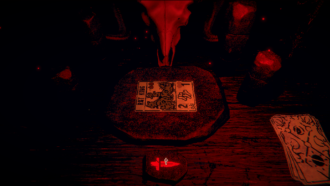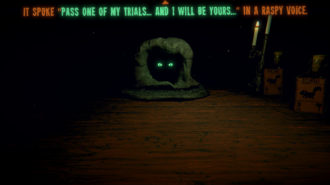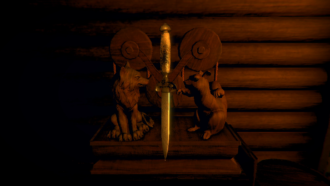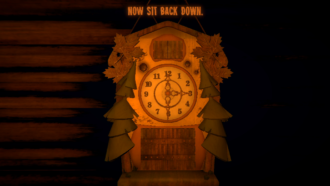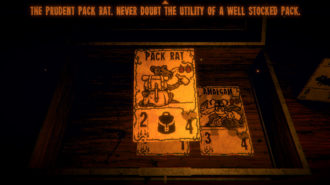Inscryption is an upcoming rogue-like deckbuilding strategy game developed by Daniel Mullins Games and published by Devolver. The game was originally announced at E3 in June 2021. Inscryption is Daniel Mullins’ third indie title after critically acclaimed Pony Island and The Hex, which are both set in strange and otherworldly environments. Inscryption follows in a similar vein. Playing as a character only known as ‘the challenger’, you’ll find yourself facing off against a mysterious demon-like character in card-based battles. The premise of Inscryption is simple: survive as many card battles as you can and escape the evil demon’s shack alive.
On the surface, Inscryption looks like other card games in the genre. At the start of a playthrough, you’ll be given a modest starter deck with a handful of cards. Your deck mostly consists of animals, some with attack and defence stats, and others with no power at all. Every playthrough sees you playing through a procedurally generated map featuring random encounters. Some encounters will have you add or upgrade cards, others involve buying goods from a shopkeeper, and others will see you engaging in a turn-based card battle.
On the battlefield, your cards come with a cost that you’ll have to fulfill to play them. However, where plenty of other deckbuilding games use a form of mana to have you play cards from your deck, Inscryption will either have you pay for cards in either blood or bones. Blood can be obtained by sacrificing creature cards already on your side of the battlefield, whereas you receive bones when one of your creatures dies by your opponent’s hand. At the start of a turn, you can draw a card from one of two piles: the squirrel pile, which consists entirely of powerless squirrel cards with the sole purpose of being sacrificed or killed for bones, and the pile containing all other creatures with an attack and defence stat. These creatures are the ones that come with a cost to be played, either in blood or bone. Every turn, creatures on both opposite sides of the battlefield will attack each other. Any unblocked damage, is dealt directly to the player, and is represented by teeth being knocked out of your — or your opponents — mouth. These teeth are then transferred to a set of old-fashioned scales sitting next to the cards, with one side of the scales representing you, and one side representing your opponent. The person who gets weighed down by the most teeth the quickest, loses the game.
While the premise of the scales and sacrificing some cards to play others was certainly spooky to me, it felt like a clever way to take some traditional card mechanics and turn them on their head. Where things start to deviate from traditional card games, however, is Inscryption’s sublime environmental storytelling. Aesthetically, Inscryption reminded me of a blend between Loop Hero, Card Hog, and Othercide, and overall, the graphics strike a creepy note.
This extends to the game’s main storyline, too. Not long after starting a playthrough, you’ll discover that you’re being kept captive in an evil character’s cabin, and that, incidentally, this character also happens to be the opponent you’re facing off against in the game’s card battles. It soon becomes clear that, while you’re being addressed as ‘the challenger’, you have little choice in the matter and are forced to partake in the game if you want to leave the cabin alive. To survive, you’ll have to find a way to win the game.
“…the mechanics and story were so well delivered that I was propelled forward by curiosity and wonder.”
Luckily, you have some helpers at hand. After playing a few rounds, you’ll find that a handful of cards in your deck aren’t like the other ones. The animals depicted on each card can talk and regularly give you hints on and off the battlefield. In between battles, you have the option to explore the cabin where you are being kept prisoner, and your card-based allies waste no time in giving you hints on how to explore the cabin and find more cards in the process. I had characters on cards give me hints about what objects in the room to have a closer look at, how to solve puzzles, and the fate of previous challengers.
On the whole, this made Inscryption feel like a unique blend of gripping horror story, deckbuilding, and escape-room-style gameplay. Where games like Slay the Spire and Monster Train only have a loosely woven story to drive the game’s core gameplay mechanics, Inscryption presented an immersive narrative. I’m not particularly fond of eerie horror games, but Inscryption’s mechanics and story were so well delivered that I was propelled forward by curiosity and wonder.
Added to this, Inscryption’s story doesn’t abruptly end once you finish a playthrough, but instead builds upon it run after run. Once you’re defeated, you’ll find yourself being thrown into a mysterious room by your captor. Before finishing you off, he has one final request: he wants to take your picture. This picture can in turn be made into a card bearing your character’s name, and once you start a new playthrough, this card will be added to your deck. It’s a masterful way to make an already strange story all the more mysterious: who is your evil opponent? What happens to your talking cards after you die? And what will happen once you finish a complete run?
Unfortunately, the demo doesn’t answer these questions, since it only includes the first act of the game. It does, however, give you a taste of what’s to come. And judging by the demo’s story, which had me firmly hooked within minutes, I think it’s safe to say that the full game will be something to look forward to even though its story might keep you up at night.
Curious? You can try out the playable teaser for Inscryption right now. The full game launches on PC on October 19.

